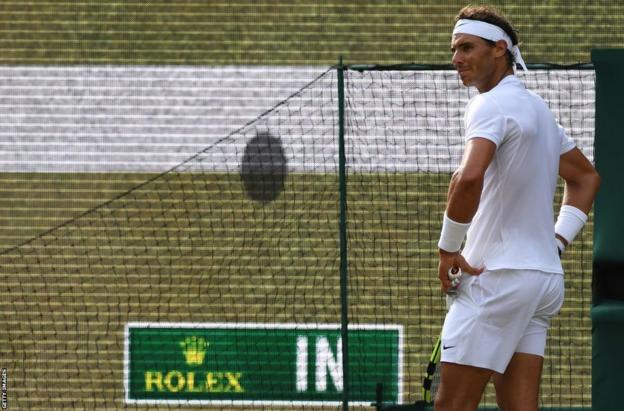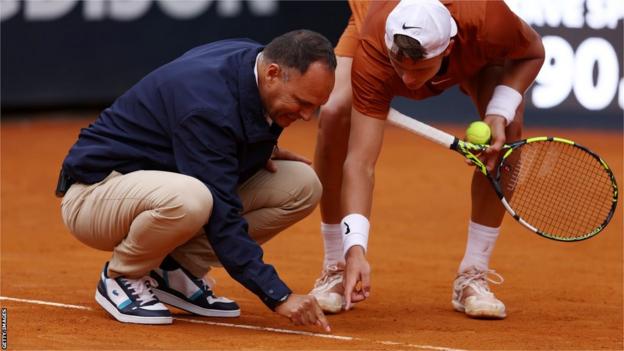Seeing a chair umpire leap right down to the court docket, scamper throughout the clay and level out the mark of a ball is without doubt one of the nice traditions of the French Open.
The scene provides to the spectacle. A way of anticipation hangs within the air, whistles or cheers from the Paris crowd – relying who the choice is for – accompany the official to the spot.
However, in a sport of excessive stakes and advantageous margins, is it time to cease relying solely on the human eye to resolve essential factors?
On the latest Italian Open, Britain’s Andy Murray was aggravated when a line name went in opposition to him as a result of the umpire dominated the ball mark was on the road.
Murray strongly disagreed. Digital line calling know-how – not used on the Rome event however seen by tv viewers – supported the previous world primary’s view.
The incident reignited a long-running debate whether or not an digital system ought to be introduced on to all courts – together with Roland Garros’ well-known terracotta surfaces.
Is the know-how unreliable on clay?
Not like the opposite three Grand Slam tournaments, that are performed on onerous or grass courts, the French Open doesn’t use the know-how in any kind.
The Australian Open and US Open – each performed on onerous courts – have already distributed with human line judges in favour of solely counting on automated calls.
Wimbledon, performed on grass, launched Hawk-Eye know-how in 2007 however the line judges stay. Gamers on the Championships are in a position to problem calls as much as thrice per set.
The French Open continues to totally belief line judges and umpires, not permitting gamers to make use of digital replays to problem human choice.
For a very long time it has been felt the pink brick mud – a high layer of 1 to 2 millimetres – compromises the accuracy and reliability of an digital system as a result of it’s a ‘reside’ floor which strikes throughout the match.
That has led to persevering with problems with confidence from gamers, commentators and followers.
However Foxtenn – one among three methods used to guage line calls in tennis, alongside Hawk-Eye and IMG Area – insists it’s dependable.
Foxtenn is the one vendor which has to date operated an digital line calling system on clay courts.
It says its ‘actual bounce know-how’ – which makes use of ultra-high-speed cameras able to producing greater than 100,000 photographs per second together with a laser scanner system – is appropriate for the floor.
“It delivers excellent and fixed real-time calibration,” say the Barcelona-based firm.
“It principally catches the whole lot that occurs on the court docket; anyplace from minute element to each unthinkable angle.”
Why would not the French Open use it?
Final month, the ATP Tour – the highest tier of males’s occasions – introduced line judges will probably be changed by an digital calling system on all surfaces on a full-time foundation from 2025.
The WTA, the governing physique of girls’s tennis, instructed BBC Sport it has “been reviewing” going full-time with digital line calling and is “very ” in making an analogous transfer to the ATP.
Remy Azemar, the French Open’s head of referees, acknowledges the know-how has been profitable at different tournaments.
But the resistance stays agency.
Two components gas the French Open’s reluctance to alter: sustaining traditions synonymous with the 100-year-old event and an unwillingness to cede human management.
“With out the presence of the road decide, it’s certainly very robotic,” mentioned Azemar. “However we should additionally recognise that it really works.
“Will it make the sport look a bit colder and emptier on the court docket? Everybody can have an opinion on that, it is not for me to reply.”
France is broadly thought of one of many strongest nations in relation to creating officers and Azemar says Roland Garros has “nothing to show” by way of its high quality of officiating.
“So long as the human referee stays in cost, we’re rather less instantly involved. We maintain the liberty to make our selections,” he mentioned.
Will we ever see it at Roland Garros?
With an growing variety of tournaments counting on digital line calling, the French Open is quick turning into an outlier by sticking with custom.
Foxtenn and Hawk-Eye have already been permitted as a assessment system on clay with line judges, with Foxtenn getting used at ATP occasions in Barcelona, Estoril, Madrid and Bastad final yr.
No vendor has but been permitted to make sole selections with out the officers. Remaining testing of the automated know-how on clay is continuous.
The ATP, the boys’s governing physique, mentioned its impending transfer will “optimise accuracy and consistency throughout tournaments, match courts and surfaces”.

Final season, there have been 30 WTA occasions which used digital line calling – together with 13 that didn’t have line umpires.
Solely two WTA clay-court occasions – Madrid and Iasi – used an digital line calling assessment system in 2022.
With a fair heavier reliance on the know-how on the horizon, Azemar conceded the French Open may very well be pressured into change.
“If 98% or 99% of the tournaments within the season are performed with out line judges, we will probably be backed right into a nook,” he mentioned.
“I feel we’ve to weigh issues up fastidiously and provides ourselves time. However we can be caught up by actuality.”
What disputes have there been lately?
Disputes over line calls are common occurrences throughout the European clay-court season and there have been various notable examples throughout the latest Italian Open.
Murray’s disagreement with Mohamed Lahyani in Rome blew up due to the three-time main champion’s big profile – and his heated response.
Lahyani was additionally concerned in one other comparable incident in Rome. The Swedish umpire decided that left Danish participant Holger Rune livid in a quarter-final in opposition to Novak Djokovic, which he ultimately received.
Rune questioned whether or not officers had been punished for “errors”, as did Russia’s Veronika Kudermetova who remonstrated with the chair umpire in her quarter-final.

On the French Open, there was a high-profile incident in 2021 that might have had much more damaging penalties.
In a dramatic semi-final in opposition to Greece’s Maria Sakkari, Czech participant Barbora Krejcikova was denied victory when chair umpire Pierre Bacchi overruled a name from a line decide on match level.
Tv replays indicated the ball was out, main Murray – watching on the tv – to say Bacchi had made an “completely brutal error”.
Krejcikova disregarded the frustration, took one other match level and received her maiden Grand Slam singles title two days later.
These disputes illustrate the confusion which nonetheless stays round clay-court marks. Whether or not the incorrect mark has been checked, or the mark just isn’t a real illustration due to physics, pressure might be created consequently.
“I do not thoughts that it is like this with line umpires judging,” mentioned Rune. “But it surely’s about the way you learn the mark. Typically it’s incorrect.”
Till the governing our bodies are glad the know-how is extra correct than the human eye, the drama over disputes will proceed – maybe over the following weeks at Roland Garros.